Summer camp is a magical time for kids—a chance to explore, make new friends, and create lasting memories. Whether it’s a day camp or an overnight adventure, the right summer camp activities can make all the difference in keeping kids entertained, active, and learning new skills. In this guide, we’ll explore a variety of fun and engaging summer camp activities for kids, from outdoor adventures to creative crafts and team-building challenges.
Need a little extra inspiration for your campers? Check out these Encouraging Camp Counselor Quotes that build confidence, spark smiles, and turn tough days around.
🍂 Ready to swap worksheets for leaf-powered learning adventures? Dive into our full guide Autumn Classroom Activities for Kids – Fun, Engaging & Unforgettable Ideas and download the free printable checklist today!
🌿 Free Printable Pack: Mindful Moments in Nature
Support emotional wellbeing at home or camp with 10 calming outdoor activities.
👉 Sign up below to grab your copy instantly!
1. Outdoor Adventure Activities
Nothing beats the thrill of outdoor exploration during summer camp! These activities help kids connect with nature, stay active, and develop confidence. Outdoor challenges not only build physical endurance but also foster teamwork, patience, and problem-solving skills.
🏕️ Scavenger Hunt Challenge
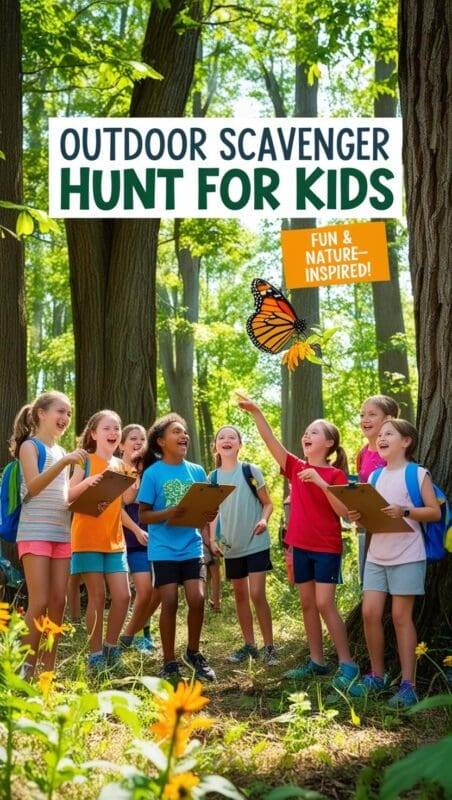
A nature-themed scavenger hunt is a summer camp classic for a reason—it encourages kids to explore, observe, and move their bodies while having fun outdoors.
How to Set It Up:
Optional: offer a small prize or certificate to the team that completes the list first or finds the most unique item.
- Choose a safe, enclosed outdoor space like a forest trail, park, or camp field.
- Prepare a printed scavenger hunt list with 10–15 items to find, such as:
- A feather
- Three types of leaves
- A stick shaped like the letter Y
- A bug (no catching—just spotting!)
3. Divide kids into small teams or pairs to encourage collaboration.
Set a timer (20–30 minutes), and let the exploration begin!
Age Appropriateness:
Best for ages 5–12. Younger campers can pair with older buddies or adults to complete the hunt safely.
Safety Tips:
- Brief kids on boundaries and safe zones before starting.
- Assign an adult to supervise each team or area.
- Avoid collecting anything fragile or potentially harmful (e.g., mushrooms, stinging insects).
- Remind kids to leave wildlife undisturbed.
Variation Idea:
Try a color-themed scavenger hunt for younger children. Have them find one item for each color of the rainbow!
🔥 Campfire Cooking & S’mores Night
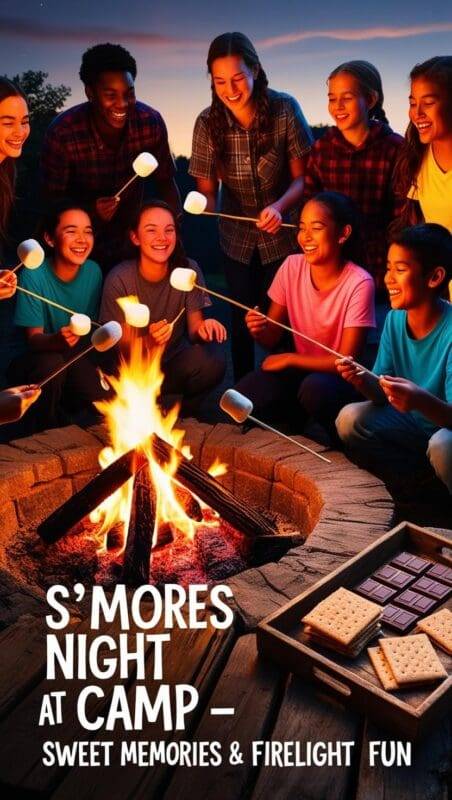
Nothing says summer camp like gathering around a crackling fire. Campfire cooking is more than just a treat—it’s a sensory-rich experience that fosters independence, teamwork, and lasting memories.
How to Set It Up:
- Choose a safe, pre-approved firepit area with water or sand buckets nearby.
- Review campfire safety rules with kids beforehand.
- Organize a simple campfire menu. Start with the classics—s’mores and roasted hot dogs—and consider adding:
- Foil packet meals (e.g., diced potatoes, carrots, and cheese)
- Fruit skewers with bananas, strawberries, and pineapple
- Campfire corn on the cob wrapped in foil with herbs
- Prep ingredients at a central station. Let kids assemble their own meals with supervision.
- Provide long roasting sticks or skewers, and rotate turns near the fire.
Materials Needed:
- Marshmallows, chocolate, graham crackers
- Hot dogs, buns, ketchup/mustard
- Aluminum foil, tongs, oven mitts
- Fire-safe skewers or sticks
- Pre-cut fruit and vegetables (for healthy options)
- Wet wipes or a handwashing station
Age Appropriateness:
Ideal for ages 6 and up. Younger kids can participate with direct adult supervision during fire-related tasks.
Safety Tips:
- Always have a responsible adult managing the fire.
- Teach kids how to handle skewers safely (e.g., point down, away from others).
- Mark a safe distance around the fire circle with logs or stones.
- Keep a bucket of water or sand nearby for quick extinguishing.
- Remind kids to never leave the fire area unattended.
Variation Idea:
Host a “Build-Your-Own Campfire Snack” station where kids choose from a variety of s’mores ingredients (e.g., peanut butter cups, flavored marshmallows, cookies) or make rainbow fruit foil packets for a healthier twist.
Want a simple way to help your camper feel connected while they’re away? Create Pocket Hugs—tiny love notes kids can carry with them for comfort all summer long.
🧗 Obstacle Course & Relay Races
Obstacle courses and relay races are perfect for boosting physical activity, coordination, and teamwork—all while letting kids burn off energy in the best way possible. Plus, they’re endlessly customizable for any group size or theme.
How to Set It Up:
- Choose a clear, open space—grassy fields, gymnasiums, or shaded camp areas work well.
- Plan a course using basic supplies. A simple setup might include:
- Cones for zig-zag running
- Ropes laid out to crawl under
- Hula hoops for jumping or hopping through
- Soft pool noodles to leap over or limbo under
- Walk kids through the course before starting.
- Time each participant or team to add friendly competition.
- Use music and cheering to energize the atmosphere.
Materials Needed:
- Plastic cones or traffic markers
- Jump ropes or soft ropes
- Hula hoops
- Pool noodles, yoga blocks, or low barriers
- Stopwatch or timer
- Themed props (optional)
Age Appropriateness:
Great for ages 4–12, with course difficulty adapted to match developmental levels. Preschoolers may need simplified tasks and closer supervision.
Safety Tips:
- Clear the area of rocks, holes, or debris before setting up.
- Choose soft materials to prevent injuries from falls.
- Assign adult supervisors at each station for guidance and encouragement.
- Emphasize sportsmanship—cheer for everyone and keep it light-hearted.
Variation Idea:
Try themed relays like a Superhero Dash (kids wear capes), Animal Safari (crawl like a bear, hop like a frog), or Pirate Treasure Hunt (run with a gold coin to a treasure chest). Themes can be easily tied into larger camp storylines or weekly units.
2. Water-Themed Fun
When the summer heat ramps up, nothing beats water play. These activities offer not just a chance to cool off, but also improve coordination, teamwork, and sensory regulation. Best of all, they can be as simple or elaborate as your space and supplies allow.
💦 Water Balloon Dodgeball
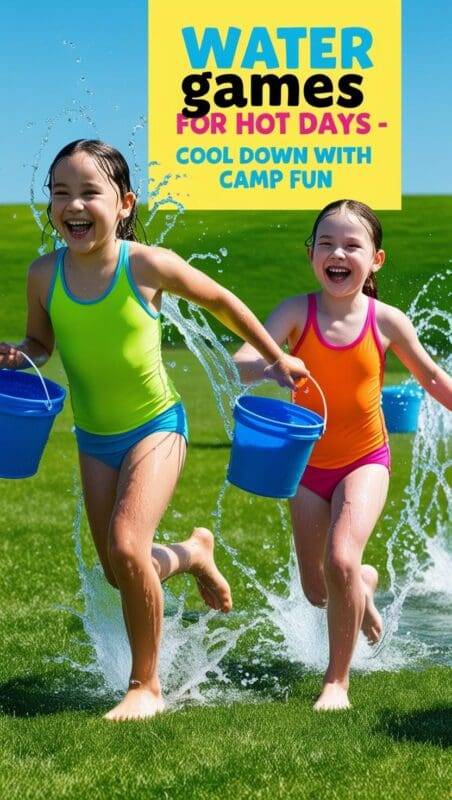
Take classic dodgeball to the next level with water balloons! This high-energy game gets kids moving, laughing, and cooling down—perfect for hot summer afternoons. It’s also great for building quick reflexes and teamwork in a fun, splash-filled setting.
How to Set It Up:
- Choose a large, open play area—preferably grassy and far from hard surfaces.
- Divide kids into two teams and establish a “no-cross” center line.
- Fill and distribute water balloons evenly between both sides.
- Add optional inflatable barriers, cones, or pool noodles as cover.
- Play in rounds—once a player is hit by a balloon, they’re out until the next round begins.
Materials Needed:
- Plenty of biodegradable water balloons (pre-filled)
- Cones or ropes to mark boundary lines
- Optional: inflatable obstacles, tarps, kiddie pools, buckets
- Towels and sunscreen
Age Appropriateness:
Best for ages 7 and up, as younger children may struggle with aiming or dodging. Teams should be mixed fairly to match coordination levels.
Safety Tips:
- Enforce a “no headshots” rule.
- Check balloons for sharp plastic remnants—always use soft, biodegradable versions.
- Avoid hard or slippery surfaces to prevent injury from falls.
- Monitor hydration and sun exposure during extended play.
Variation Idea:
Create themed “battle zones” by assigning team names (like “Fire & Ice” or “Sharks vs. Surfers”) and decorating zones with colored balloons, team bandanas, or music. You can even award bonus points for creative team spirit!
🏊 Pool Games & Races
If your camp has access to a pool, lake, or splash zone, you’ve unlocked a whole new level of summer fun. Water-based games help develop coordination, endurance, and team skills—all while offering a refreshing escape from the heat.
How to Set It Up:
- Choose games based on swimming ability—create zones for strong swimmers and shallow-water players.
- Organize small group rotations or team competitions for engagement.
- Keep extra towels, sunscreen, and lifeguards or adult supervisors on standby.
Favorite Pool Game Ideas:
- Sharks and Minnows:
One child is the “shark” and stands in the middle. The “minnows” try to swim across the pool without being tagged. Those tagged become sharks. - Floating Relay Races:
Use pool noodles, kickboards, or inflatables for team relay races across the pool. Great for strong swimmers. - Treasure Dive:
Toss weighted rings or pool toys into shallow areas. Kids dive to collect as many as they can in 30 seconds.
Materials Needed:
- Pool noodles, kickboards, or small inflatables
- Diving rings or pool-safe toys
- Whistle and stopwatch (optional)
- Poolside towels, sunscreen, and drinking water
- Safety signage and floatation devices (for young or non-swimmers)
Age Appropriateness:
Best for ages 6 and up. For younger campers or non-swimmers, stick to shallow zones or assign 1:1 supervision with life jackets.
Safety Tips:
- Always require adult supervision—lifeguards if possible.
- Separate shallow and deep water activities.
- Remind kids of safe pool behavior: no pushing, dunking, or running.
- Have a clear “pool break” time for rest, snacks, and hydration.
Variation Idea:
Try a synchronized swim challenge—kids team up to perform short, silly routines to music. It’s less about technique and more about laughter and teamwork!
🚣 Canoeing & Paddleboarding
For older campers, water sports like canoeing, paddleboarding, and kayaking offer a deeper connection with nature—and a thrilling sense of adventure. These activities promote balance, focus, and resilience while introducing kids to lifelong outdoor skills.
How to Set It Up:
- Choose a calm body of water such as a lake, lagoon, or slow-moving river.
- Group campers by experience level and give a short land-based demo.
- Provide all required safety gear: life jackets, paddles, and sun protection.
- Begin with short, supervised paddles along the shoreline before extending the route.
Materials Needed:
- Canoes, paddleboards, or kayaks (adjust per group size)
- Paddles
- Certified life jackets (one per child)
- Hats, sunscreen, and water bottles
- Optional: waterproof bags for belongings
Age Appropriateness:
Ideal for ages 8+, depending on swimming ability and comfort level. Beginners should be paired with instructors or adults in multi-person canoes.
Safety Tips:
- All participants must wear life jackets at all times.
- Check equipment before each session for damage or loose parts.
- Use a buddy system and keep a support boat or supervisor nearby.
- Avoid open water and set clear boundaries for distance and time.
Variation Idea:
Try a team paddle challenge where kids navigate a short course with checkpoints. You can also offer a sunrise or sunset paddle for older campers to reflect and wind down the day.
🌿 Free Printable Pack: Mindful Moments in Nature
Support emotional wellbeing at home or camp with 10 calming outdoor activities.
👉 Sign up below to grab your copy instantly!
3. Creative Arts & Crafts
Arts and crafts are a quiet, grounding break from high-energy camp activities—and they offer so much more than fun. These hands-on projects support fine motor development, creativity, and emotional expression while giving campers something special to take home.
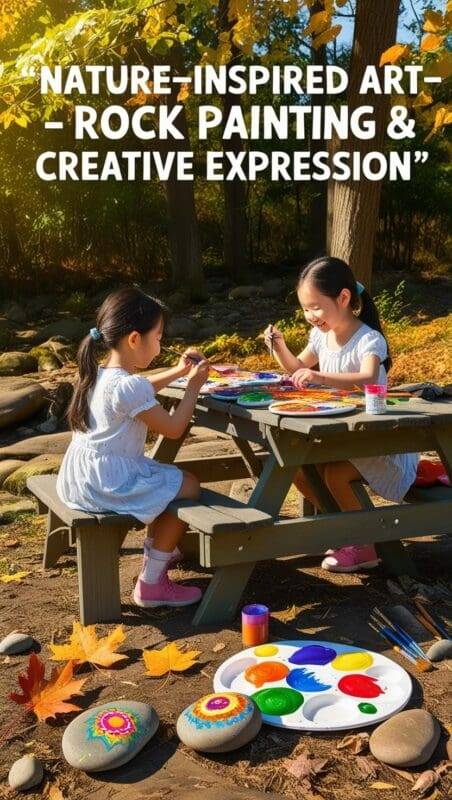
🎨 Nature Painting & Rock Art
Blending creativity with nature, rock painting and eco-inspired art projects help kids connect with the outdoors while expressing themselves. These crafts are low-cost, open-ended, and meaningful—perfect for calm afternoons at camp.
How to Set It Up:
- Take campers on a short nature walk to collect smooth, dry rocks or natural items like leaves and twigs.
- Set up a painting station with washable paints, brushes, water cups, and drying trays.
- Offer design inspiration: words of encouragement, animal faces, colorful patterns, or abstract nature art.
- Use cardboard or recycled containers to safely carry finished pieces.
Materials Needed:
- Smooth stones or pebbles (hand-sized)
- Non-toxic acrylic paints or paint pens
- Paintbrushes and cups of water
- Newspaper or cloth to protect tables
- Leaves, twigs, bark, and natural elements (for printing or dyeing)
- Optional: Mod Podge or sealer spray (for preserving finished rocks)
Age Appropriateness:
Perfect for campers ages 4+. Younger children may enjoy painting with their hands or using sponges; older kids often explore more detailed designs.
Safety Tips:
- Choose only child-safe, washable paints and sealants.
- Avoid collecting rocks from protected areas or habitats.
- Supervise paint use to prevent spills or ingestion.
- Allow painted rocks to fully dry before handling or packing to take home.
Variation Idea:
Create a “Kindness Rock Garden” where each child contributes a rock with an encouraging word or message. You can also host a nature art gallery walk by displaying painted pieces along a trail or near the campfire area.
📸 DIY Camp Scrapbook
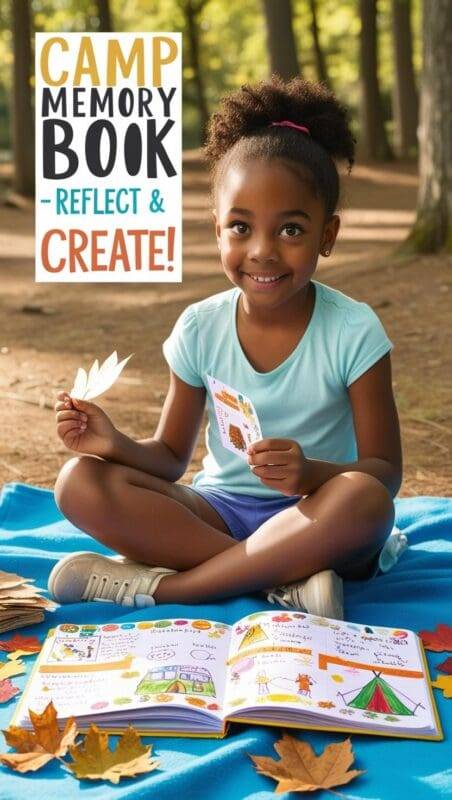
A DIY camp scrapbook is a beautiful way to help kids reflect on their experiences and capture memories they’ll treasure long after camp ends. This activity supports creativity, self-expression, and emotional awareness—and it’s often a quiet favorite among campers.
How to Set It Up:
- Provide each camper with a small blank journal or stapled booklet at the beginning of the week.
- Set aside quiet time each day for writing or decorating.
- Encourage kids to add doodles, nature finds, or reflections on their favorite moments.
- Offer journaling prompts like:
- “What made me smile today?”
- “Something I tried for the first time…”
- “A person who helped me feel included…”
Materials Needed:
- Small blank notebooks or DIY booklets
- Markers, crayons, pens, and colored pencils
- Washi tape, glue sticks, safety scissors
- Stickers, stamps, old magazines for collage
- Envelopes or zip pouches for storing found objects (leaves, ticket stubs, etc.)
- Optional: disposable camera or instant photos
Age Appropriateness:
Recommended for ages 6 and up, with younger kids needing extra support for writing and idea generation. Older campers often engage deeply with journaling and creative reflection.
Safety Tips:
- Use age-appropriate scissors and glue.
- Supervise younger kids closely during cutting or collage sessions.
- Ensure allergy-friendly materials if collecting natural items.
Variation Idea:
At the end of camp, host a “Memory Share Circle” where kids can read a favorite entry, show their decorated page, or simply reflect on something that stood out to them. It’s a meaningful way to build closure and boost emotional connection.
🎭 Talent Show & Skit Night
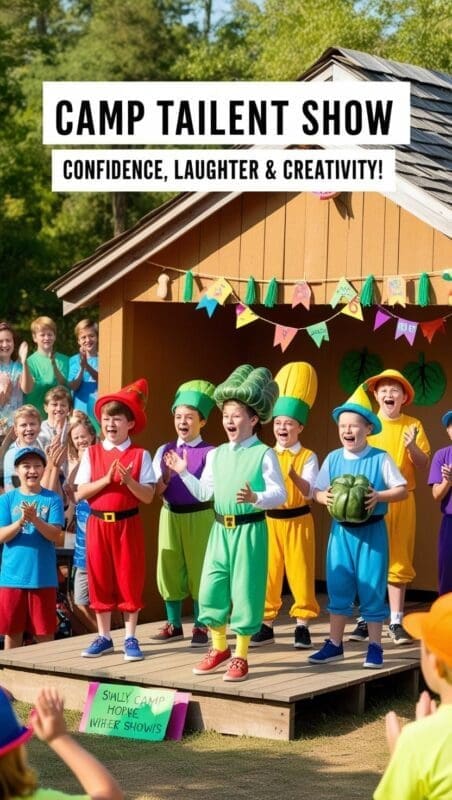
A camp talent show is often the most anticipated event of the week—and for good reason. It’s a stage for kids to shine, express themselves, and cheer each other on. Whether it’s a solo song, a group skit, or an improvised dance, this activity builds confidence, creativity, and a strong sense of community.
How to Set It Up:
- Announce the talent show early in the week to give campers time to prepare.
- Offer sign-up sheets and help kids brainstorm ideas.
- Set aside a rehearsal time and optional “mentors” (counselors or older campers) to support shy participants.
- Designate a stage area—indoors or out—with chairs or blankets for the audience.
- Use simple decorations, a microphone (optional), and spotlight time for each act.
Materials Needed:
- Sign-up sheets
- Costumes, props (scarves, hats, plastic instruments)
- Music player or speaker
- Markers, paper for programs or signs
- Optional: stage lights, microphone, backdrop
Age Appropriateness:
Perfect for ages 5 and up, with performances tailored to developmental levels. Younger children may prefer group acts or guided skits, while older kids often enjoy creating their own routines.
Safety Tips:
- Ensure props and costumes are safe and non-restrictive.
- Assign a staff member to help with transitions and manage nerves.
- Keep performances inclusive and kind—no “booing” or jokes at others’ expense.
- Set a respectful time limit per act to keep energy high.
Variation Idea:
End with a counselor act to surprise the kids and leave them laughing—or hand out lighthearted “camp awards” like “Most Creative Dance” or “Best Use of Props.”
4. Team-Building & Social Activities
One of the greatest gifts of summer camp is friendship—and team-building games help nurture that connection. These activities are designed to build trust, improve communication, and develop social-emotional skills like empathy, leadership, and cooperation.
🧩 Giant Jenga & Problem-Solving Games
Big games make a big impact—especially when they challenge kids to think critically and work together. Whether you’re stacking oversized blocks or untying a human knot, these activities promote focus, patience, and communication.
How to Set It Up:
- Set up a large play area with space for group movement and thinking.
- Introduce the activity as a team-based challenge where collaboration is key.
- Encourage campers to share ideas, take turns, and support one another throughout.
🔠 Game Ideas:
- Giant Camp Jenga:
Use a jumbo Jenga set and write prompts on each block like “Share a fun fact,” “Name your favorite camp meal,” or “Tell a joke.” Every turn becomes a social bonding moment. - Escape the Rope (Human Puzzle):
In pairs or small groups, kids are loosely tied together with soft rope or loops. They must work together to untangle themselves without removing the ropes—testing spatial awareness and collaboration. - Mystery Bag Problem-Solver:
Give each group a bag filled with random items (e.g., string, clothespins, plastic cups) and challenge them to build a bridge, tower, or “trap” for a stuffed animal.
Materials Needed:
- Giant Jenga set (or DIY wooden blocks)
- Rope loops or scarves
- Small mystery bags with craft supplies
- Paper and pens (for clues or challenges)
- Optional: stopwatch or timer for added excitement
Age Appropriateness:
Recommended for ages 7 and up, as many of these activities require basic strategy skills and peer negotiation. With guidance, younger campers can also enjoy simplified versions.
Safety Tips:
- Supervise rope games closely to prevent tangling or frustration.
- Use soft, flexible materials (no knots that tighten).
- Encourage fair play and taking turns with group materials.
Variation Idea:
Turn Jenga into a Camp Story Tower—each block pulled prompts the camper to add a sentence to a silly group story. By the end, the team has built not only a tower but a fun shared memory.
🏹 Archery & Target Practice
Archery is a camp favorite that teaches patience, precision, and self-discipline. When properly supervised, it’s not just exciting—it’s an empowering way for kids to challenge themselves and celebrate improvement. For a low-risk alternative, foam dart or suction cup target practice provides all the fun with less setup.
How to Set It Up:
- Choose a wide, open area with a clear, safe shooting lane and plenty of space behind the targets.
- Mark off a spectator/safety zone with cones or rope.
- Offer a demonstration and safety overview before anyone participates.
- Start with basic target shooting, then introduce challenges or themed rounds for variety.
Materials Needed:
- Archery bows and blunt-tip arrows (youth-sized)
- Foam dart blasters or suction cup arrows (for safer alternatives)
- Target boards, paper bullseyes, or printed character cutouts
- Safety goggles (if using foam blasters)
- Cones, ropes, or signage to mark the safe zone
Age Appropriateness:
- Archery: Ages 8 and up, under direct adult or certified instructor supervision.
- Foam dart target games: Ages 5 and up, especially great for younger campers.
Safety Tips:
- Always supervise archery with trained staff and enforce one-shooter-at-a-time rules.
- Store bows and arrows separately when not in use.
- Clearly mark boundaries and provide visual cues for safe distances.
- For foam games, ensure targets are stationary and that kids wear goggles if needed.
Variation Idea:
Create themed targets like dragon eyes, camp mascot cutouts, or balloon boards with hidden prizes inside. You can also hold a target tournament, awarding points for accuracy, creativity, or teamwork.
⚽ Camp Olympics
There’s no better way to wrap up camp than with a high-energy, all-inclusive Camp Olympics. This event gives kids a chance to show off their skills, celebrate teamwork, and enjoy some healthy competition—or just join in the fun. With a mix of physical and creative challenges, every camper can feel like a winner.
How to Set It Up:
- Choose an open field or large multi-use space and divide it into activity stations.
- Organize campers into mixed-age teams and rotate them through events.
- Use fun team names and colored bandanas or flags for a festive touch.
- Keep scores optional—or celebrate everyone with awards based on participation, effort, and spirit.
🏃 Popular Olympic-Style Events:
- Sprint races or 3-legged races
- Tug-of-war with a soft rope
- Sack races or wheelbarrow relays
- Jump rope contests (most jumps in 1 minute)
- Target toss with beanbags or water balloons
🧠 Inclusive & Creative Alternatives:
- Team Puzzle Challenge: Groups race to complete a large jigsaw puzzle together.
- Camp Trivia Relay: Teams answer silly or educational camp questions between physical tasks.
- Relay Storytelling: One camper starts a story, the next continues it, and so on—fun and hilarious results guaranteed.
Materials Needed:
- Cones, ropes, sacks, beanbags, hula hoops
- Bandanas, team flags or identifiers
- Stopwatch, clipboards, printed scorecards
- Certificates, ribbons, or small “gold” medals (DIY or printable)
Age Appropriateness:
Suited for ages 5–12, with activity adjustments based on skill level. Younger kids may need paired teammates or simplified challenges.
Safety Tips:
- Clearly define event boundaries and rules before starting.
- Have adults stationed at each challenge to guide and cheer.
- Offer water breaks, sunscreen reapplication time, and shaded rest zones.
- Emphasize effort, fun, and sportsmanship over winning.
Variation Idea:
End the event with a Camp Parade, where each team marches around the camp with their flags or banners, then gathers for a group photo and a closing ceremony to hand out awards or memory booklets.
5. Nighttime Campfire Traditions
As the sun sets and the campfire crackles, something special happens—campers settle into a rhythm of reflection, connection, and quiet joy. These nighttime rituals create powerful memories and a sense of belonging that lingers long after camp ends.
📖 Storytelling Under the Stars
There’s something timeless about storytelling beneath a starlit sky. Whether it’s spooky camp legends, laugh-out-loud tales, or collaborative adventures, these moments foster imagination, connection, and a sense of wonder. It’s the perfect way to wind down and bond before bed.
How to Set It Up:
- Create a cozy, low-lit campfire circle or lantern-lit space under the stars.
- Invite campers to sit close together on blankets or logs.
- Start with a counselor-led story to set the tone, then open the floor for camper participation.
- Use a flashlight, “story stone,” or special item that gets passed around to indicate who’s speaking next.
✨ Types of Stories to Share:
- Spooky Stories: Keep them light-hearted and age-appropriate—think mysterious sounds in the woods or talking animals rather than scary jump-scares.
- Funny Tales: Counselors can tell outrageous (but clean) stories from their “childhood” or made-up adventures.
- Made-Up Camp Legends: Invent a silly myth about a creature that lives in the woods, only to be revealed as a raccoon who loves marshmallows.
- Collaborative Storytelling: One camper starts a story, then each child adds a sentence. The results are often unpredictable and hilarious!
Materials Needed:
- Flashlight or storytelling prop (lantern, “magic” stick, stuffed mascot)
- Blanket seating or camp chairs
- Optional: background nature sounds, twinkle lights for ambiance
- Notebook (if you want to write the group story down)
Age Appropriateness:
Great for ages 5 and up, with different story types matched to attention spans and comfort levels. Younger kids can help act out parts instead of telling.
Safety Tips:
- Supervise flashlight and seating placement to avoid tripping.
- Offer a safe word or gesture if someone gets too scared or wants to stop.
- Avoid themes that are too frightening or emotional for sensitive campers.
Variation Idea:
Host a “Starry Story Awards Night” at the end of camp—hand out silly awards like “Most Unexpected Plot Twist” or “Best Story Voice” to celebrate participation and creativity.
🎶 Campfire Songs & Music Jam
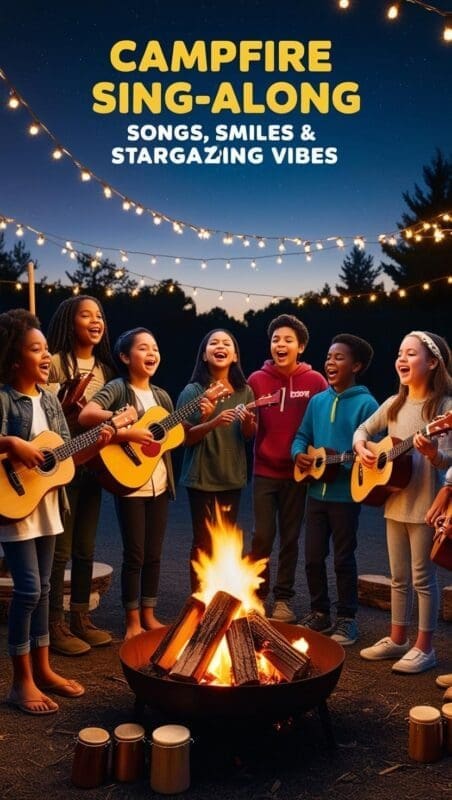
Music has a way of bringing everyone together—and around the campfire, it becomes magic. Singing familiar tunes, playing instruments, or inventing silly songs creates joy, laughter, and unity. It’s an experience kids will remember for years.
How to Set It Up:
- Choose a cozy campfire area or lantern-lit circle for an evening music session.
- Bring simple instruments like a guitar, ukulele, or portable speaker for accompaniment.
- Start with well-known songs to encourage participation, then invite kids to join in with rhythm instruments or their voices.
- Encourage creativity—kids can invent their own lyrics or even full camp songs in groups.
🎤 Song & Jam Ideas:
- Classic Campfire Songs: “Down by the Bay,” “The Campfire Song Song,” “Boom Chicka Boom,” “Country Roads”
- Call-and-Response Songs: Great for younger kids—repetitive and easy to follow
- Make-Your-Own Song: Let campers write verses about their favorite camp memories or silly animals
- Rhythm Circle: Pass out tambourines, shakers, and hand drums for a freestyle percussion jam
Materials Needed:
- Acoustic guitar, ukulele, or Bluetooth speaker
- Printed or memorized lyrics
- Tambourines, shakers, hand drums (or DIY versions)
- Seating (blankets, logs, benches)
- Optional: glow sticks or fairy lights for ambiance
Age Appropriateness:
Great for ages 4 and up. Even toddlers can join in with rhythm instruments, while older kids might lead a song or play an instrument.
Safety Tips:
- Keep instruments a safe distance from the fire.
- Use soft, child-friendly percussion tools (nothing sharp or overly loud).
- Ensure all wires (if using a speaker) are tucked safely to avoid tripping.
Variation Idea:
Hold a “Camp Jam Night” where each cabin or group performs a song they wrote together. Award fun titles like “Most Creative Lyrics” or “Best Beat.”
🌓 Glow Stick Night Games
When the stars come out, camp takes on a whole new kind of magic. Glow-in-the-dark games spark imagination and adventure, while helping kids burn off a bit of energy before winding down. It’s an exciting way to turn nighttime into a sensory-rich experience.
How to Set It Up:
- Choose a safe, open area away from hazards like roots, rocks, or uneven ground.
- Give each camper a glow stick, bracelet, or necklace to help with visibility.
- Explain the rules clearly before play begins and assign boundary markers using cones or reflective tape.
- Optional: use glow-in-the-dark face paint for added fun.
🌌 Game Ideas:
- Glow Tag: One camper wears a different colored glow stick and becomes “it.” The rest try to avoid being tagged in a low-light zone.
- Flashlight Hide-and-Seek: Players hide while one person searches with a flashlight.
- Glow Stick Dance Party: Play music and let campers dance under the stars with glow sticks.
- Constellation Spotting: Lay out blankets and use star maps or apps to identify constellations in the sky.
Materials Needed:
- Glow sticks, necklaces, or bracelets (enough for all campers)
- Flashlights or lanterns
- Cones, string lights, or reflective tape (to define safe boundaries)
- Music speaker (optional)
- Printed star charts or a stargazing app
- Blankets or mats for stargazing
Age Appropriateness:
Suitable for ages 5 and up, with simplified rules and closer supervision for younger campers.
Safety Tips:
- Always check the play area during daylight for potential tripping hazards.
- Use glow sticks to keep campers visible at all times.
- Assign counselors to monitor the game zone perimeter.
- Ensure kids stay hydrated and dress warmly for evening temperatures.
Variation Idea:
Host a Glow Olympics, where campers rotate through glow-themed stations like “Glow Ring Toss,” “Light Trail Limbo,” or “Starlight Freeze Dance.”
Final Thoughts: Make Summer Camp Unforgettable
Summer camp is all about adventure, creativity, and making lifelong friendships. By including a mix of outdoor fun, water activities, arts & crafts, team challenges, and nighttime traditions, you can ensure kids have an unforgettable experience. Whether they’re roasting marshmallows, exploring nature, or splashing in the water, these summer camp activities for kids will keep them engaged, learning, and having the time of their lives!
🍂 Ready to swap worksheets for leaf-powered learning adventures? Dive into our full guide Autumn Classroom Activities for Kids – Fun, Engaging & Unforgettable Ideas and download the free printable checklist today!
🌿 More Ways to Support Kids’ Emotional Growth:
- Encouraging Camp Counselor Quotes That Kids Need to See (And Wear) This Summer – Boost confidence and brighten even the toughest camp days with these powerful, wearable words.
- Pocket Hugs & Painted Reminders: How Small Daily Love Notes Help Kids Feel Secure – A tiny reminder from home can make all the difference in helping campers feel safe and loved.
- How Can a Counselor Help a Child? – Discover when a little extra support from a counselor can make camp (and life) feel more manageable for your child.
- Primitive Reflex Integration in Children: A Key to Unlocking Better Behavior, Learning, and Emotional Well-Being – Understand deeper emotional needs that can affect your child’s camp experience and beyond.
🌿 Free Printable Pack: Mindful Moments in Nature
Support emotional wellbeing at home or camp with 10 calming outdoor activities.
👉 Sign up below to grab your copy instantly!

About the Author
Hi, I’m Eve, a former school counselor with a master’s degree in School Psychology and a passionate advocate for children and families navigating sensory challenges. As a mom of children with sensory sensitivities, I deeply understand the journey special-needs parents face, and I dedicate myself to researching and sharing practical solutions to help children thrive and feel comfortable in their bodies. My goal is also to empower counselors, therapists, and psychologists with creative strategies and supportive resources to enrich their everyday practice. When I’m not writing or exploring new therapeutic approaches, you’ll find me spending quality time with my family and continually seeking inspiration from everyday moments.


